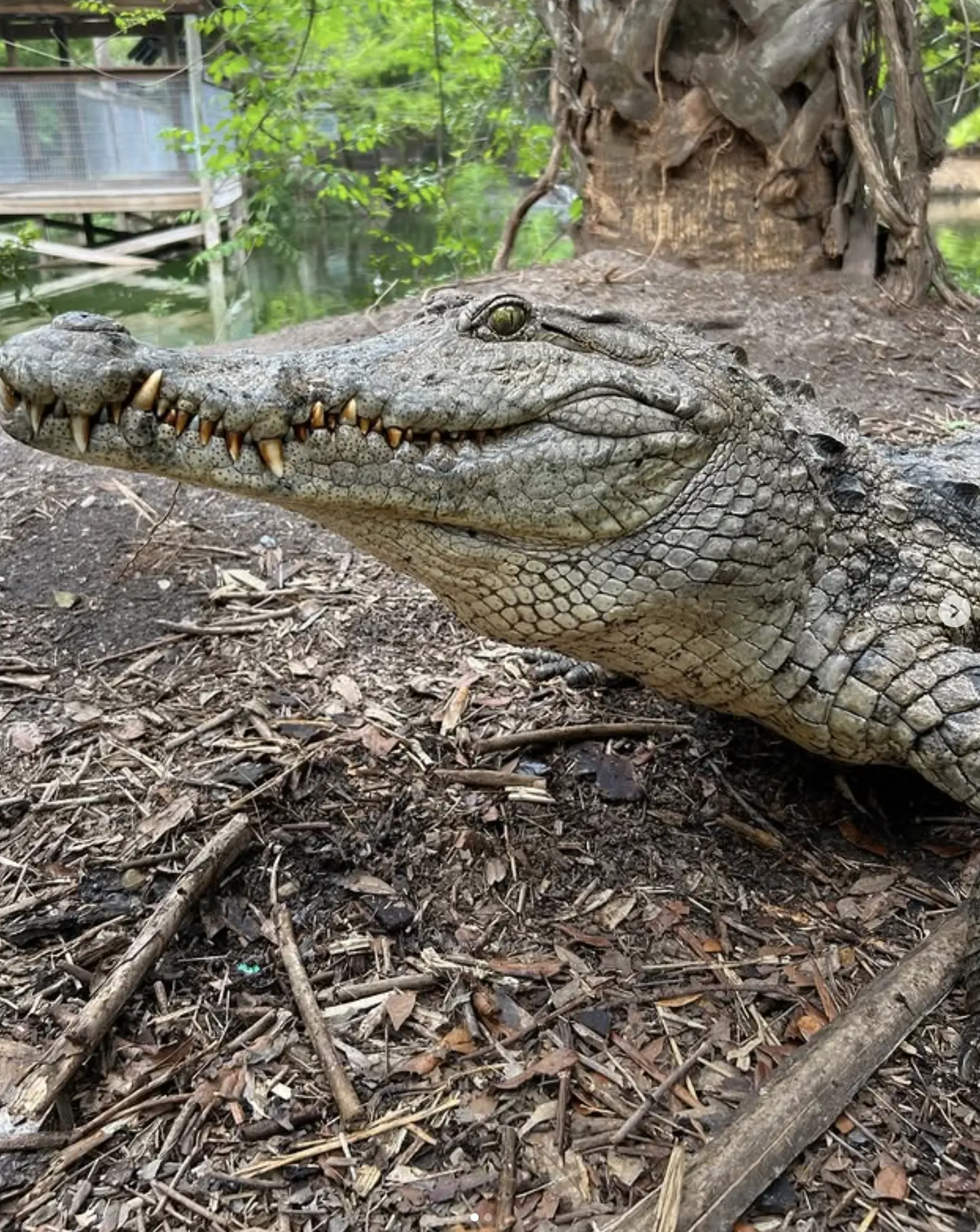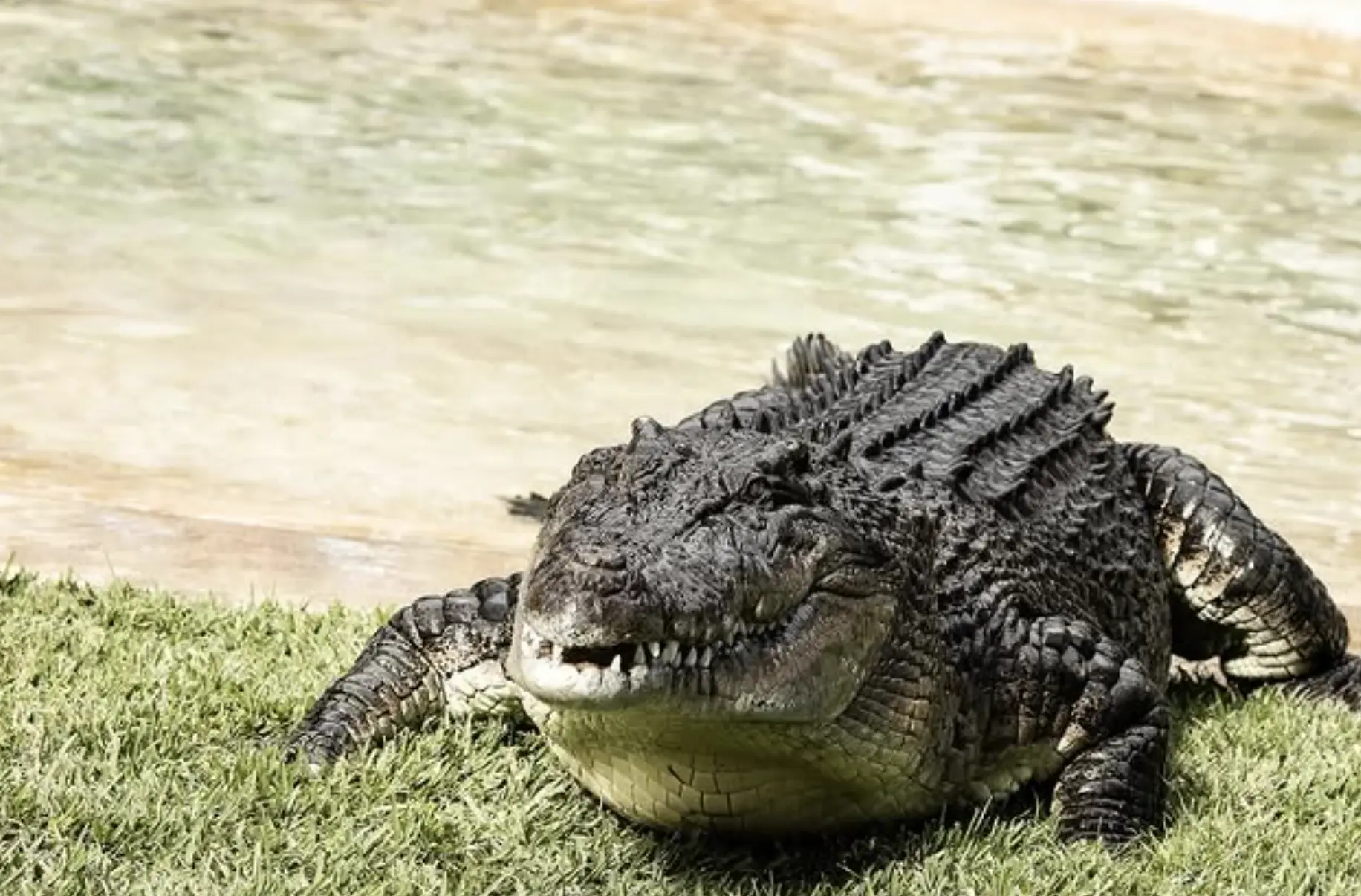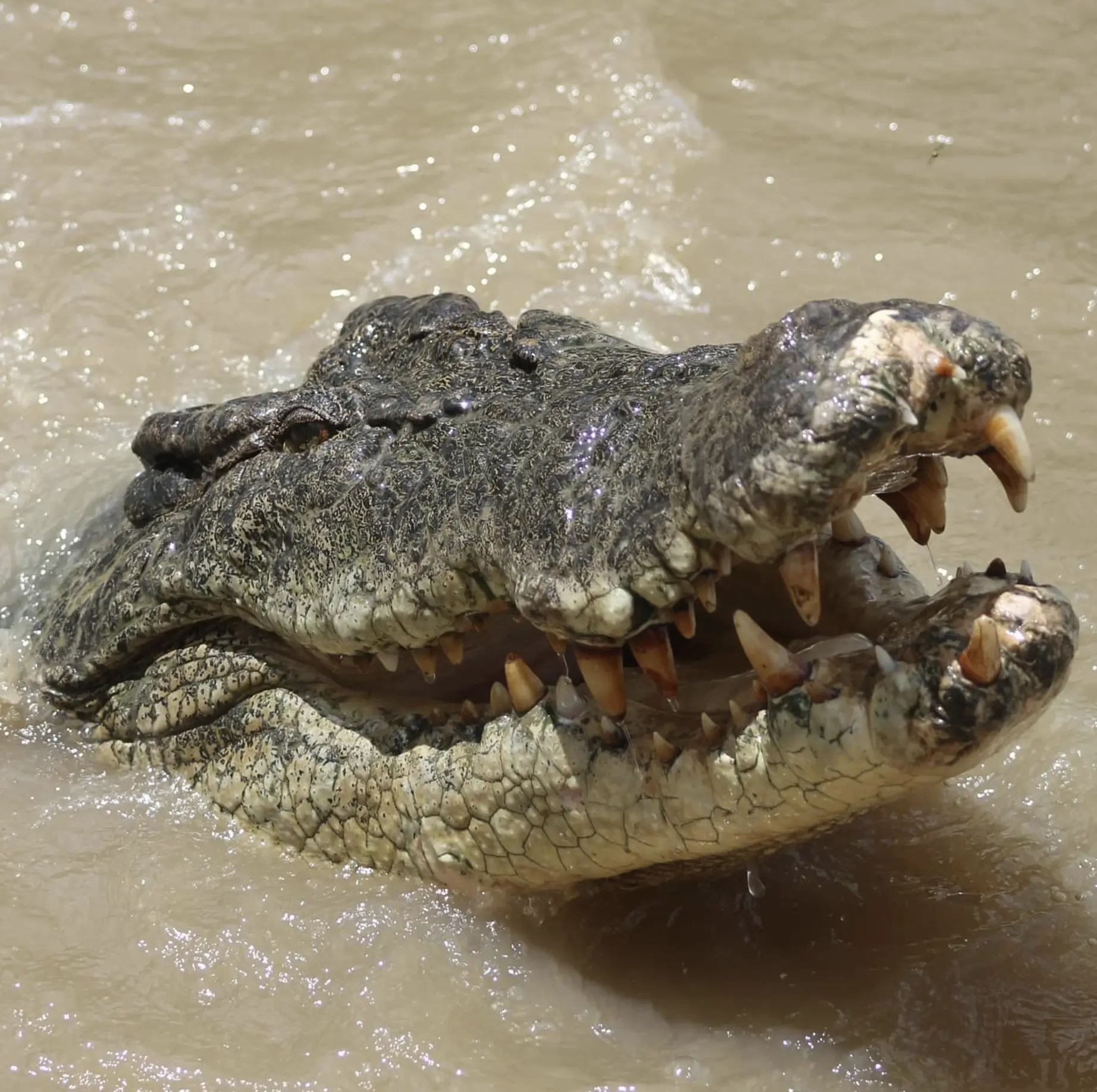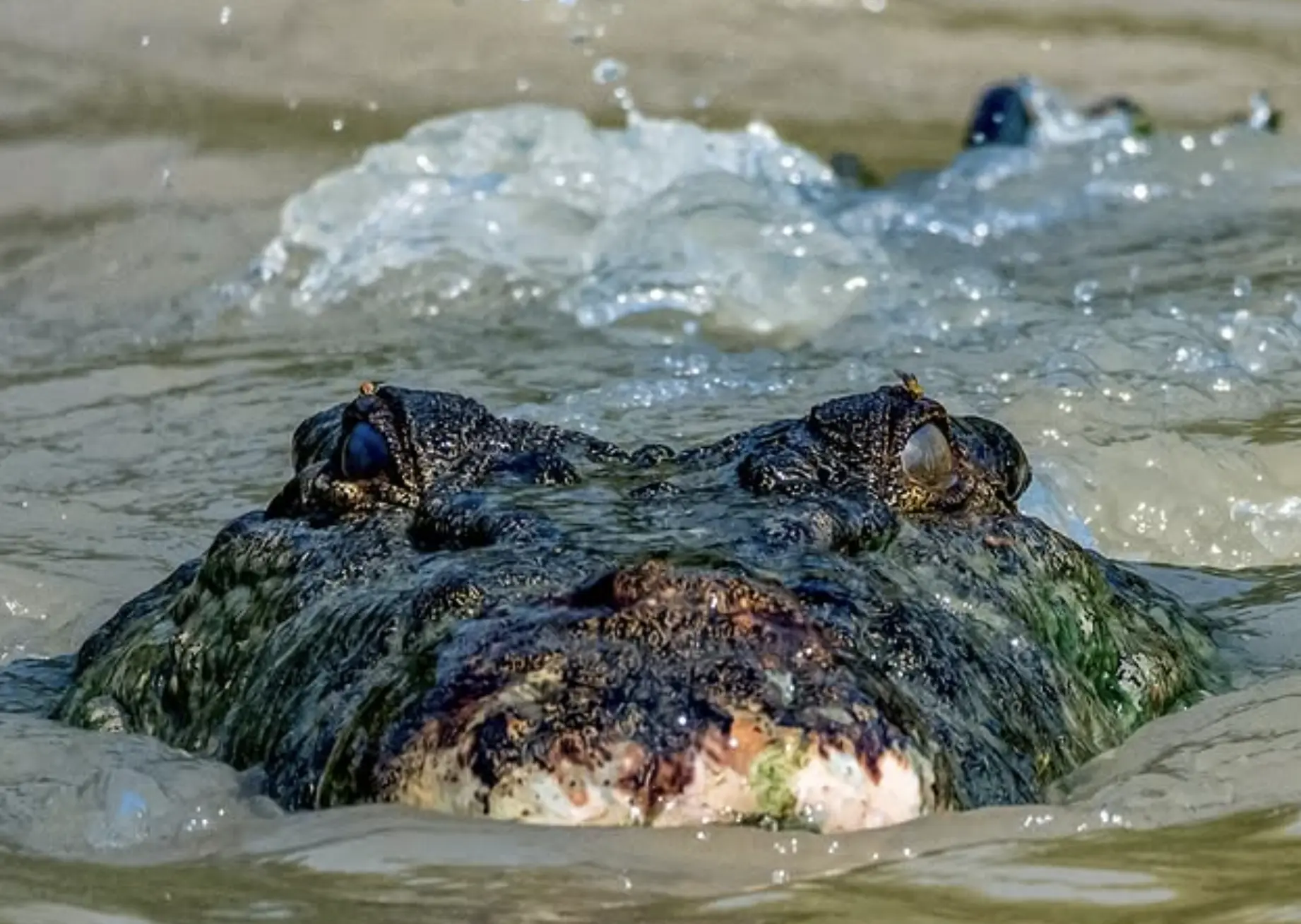The freshwater crocodile may not be a show-off, but it’s a tough, adaptable survivor. Living in flood waters, freshwater wetlands and inland waters, it’s shaped by Australia’s landscape.
From body to behaviour, from dry season basking to wet season floods, the freshwater croc is a living link to Australia’s deep-time story. Just remember: it may look chilled, but it’s still a croc.
Table of Contents
A Croc with a Mellow Mood (Mostly)
You’ve heard of salties – those massive, aggressive saltwater crocodiles that dominate headlines and Top End waterways. But what about their smaller, more reserved cousin? Enter the freshwater crocodile (Crocodylus johnsoni or Crocodilus johnsoni) – or as we locals call them, freshies. They’re the quiet achievers of croc country, living a more low-key life in Australia’s inland waters like freshwater wetlands, billabongs and banks of lakes.
They’re usually sunning themselves on a rock in shallow water, eyeing you with that reptilian calm. Compared to salties, they’re less territorial, rarely aggressive towards humans and far more polite when it comes to sharing a waterhole (but let’s be clear: still wild animals with sharp teeth and a knack for catching prey).
Let’s get into what makes the freshwater crocodile a fascinating creature of Australia’s wild heart.


Friendlier, But Still Wild
Key Features:
- Long, thin head and narrow snout
- Lighter colour than salties — more grey-brown with darker bands and dark patches across the back
- Triangular scales along the back and tail
- Freshwater habitats but can tolerate brackish waters
- Males are about 2–3 metres; females are smaller
- Live up to 50–60 years in the wild
- Reach sexual maturity at an intermediate size (females smaller than males)


Natural History: From Ancient Reptile Stock
The freshwater crocodile is a living fossil – part of a crocodile species that dates back over 200 million years. These ancient reptiles have survived mass extinctions, climate changes and the rise and fall of the dinosaurs. As part of the Australian reptiles group, they’re endemic and well adapted to our crazy seasons.
Unlike more widely spread species like the American crocodile or Cuban crocodile, the freshwater croc is homegrown. It was first described in the 19th century and thrives in inland waters, evolving its long head, conical teeth and triangular scales to suit Australia’s unique waterways and water bodies.
Distribution and Habitat: Where to Find Them
The Australian freshwater crocodile is found in the northern third of the country. Look for them in:
- Kakadu National Park (NT) – Maguk, Jim Jim Creek and upstream areas of Twin Falls
- Nitmiluk Gorge (NT) – especially in the dry season when the water is shallow
- Lake Argyle (WA) – massive population here, often seen on cruises
- Lawn Hill Gorge (Boodjamulla NP, QLD) – paddle past them in a canoe, they’ll just watch you float by
- Douglas Hot Springs (NT) – freshies often bask on the edges in cooler months
Remember: clear signage and local advice matter. Just because it looks.
They prefer permanent bodies of fresh water – things like deeper water bodies, dry season water bodies and flood waters that linger after the wet season. While they can handle brackish waters, they generally avoid tidal reaches dominated by estuarine crocodiles. These shy creatures prefer cooler water, still pools or shallow water near the edges of lakes. They’re often seen basking near water during the dry season but will disperse with the floods once the wet season starts.


Physical Characteristics: The Slimline Croc
Freshies are different to larger crocodiles like salties. Here’s the lowdown:
- Average size: 2 to 3 metres
- 4-metre (13-foot) individuals confirmed but rare
- Body shape: Slim with a long head and solid head
- Body scales: Tan to olive with dark patches and darker bands on the tail
- Hind legs and hind feet allow for surprising speed on land
- Teeth: Up to 68 needle-like chompers
Larger adults may look more intimidating but even female freshwater crocs have a decent bite. Their eyes are high on their head, perfect for sneaking up while mostly submerged.
Biology and Behaviour: Calm, but Croc-like
Despite being freshwater crocodiles, these are shy animals. You’ll usually find them alone or loosely grouped at good basking spots.
Behavioural facts:
- Mostly active at dusk and night
- Spend part of the day on land to sunbake and regulate body heat
- Can do sideways action and scuttle runs
- Breathe using deoxygenated blood redirection to manage blood flow when diving
They’ll retreat if disturbed – but never mistake their calm for tameness. A defensive crocodile will lash out, and even an intermediate size individual can leave a nasty mark.


Reproduction: Dry Season Courtship
Freshies breed in the breeding season, usually early dry season (May to August). After mating, female crocodiles dig nests in sandbanks above water level.
Breeding details:
- Clutch size: About 13 eggs
- Egg-laying period: Peak mid-dry season
- Incubation temperature: Determines sex (warm = males)
- Hatching: Around late dry season (Aug–Oct)
- Breeding size: Reached at sexual maturity, varies by climate and average temperatures
Female freshwater crocodiles may guard the nest but are less hands-on than salties. Still, they respond to the hatchlings’ calls and help transport them to water. Survival rates are low – birds of prey, pythons and other predators take their toll.
Feeding and Diet: What’s on the Menu
These crocs don’t eat like salties. They’re quick hunters, focused on vertebrate prey they can grab in a flash.
Typical diet:
- Fish, invertebrates, and insects
- Frogs
- Crustaceans
- Small reptiles or mammals like adult mice
- Exotic fish species when available
They ambush – hang near shallow water or under cover and then snap sideways with lightning speed. It’s this capture of prey technique that makes them some of the fastest crocodiles at close range.
They prefer common food items that can be eaten whole. In captivity they may eat rodents, but in the wild, food availability changes with season and flood cycles. Their favourite food is what’s available – they’re adaptable feeders.


Relationship with Humans
Freshies have a pretty chill rep. Unlike the saltwater crocodile, they don’t see people as threats or food.
Still, attacks do happen – a few freshwater crocodile attacks occur each year, often involving people swimming in remote areas or trying to handle captive individuals. If left alone, they’ll do the same.
Safe spots where freshwater crocodile hatchlings are often seen:
- Billabong Sanctuary
- Australia Zoo
- Lake Argyle eco tours
Because of competition with saltwater crocodiles, some populations are squeezed out of crocodile habitat. The crocodile populations in certain areas like Kakadu are monitored closely.
They’re protected under national law, with a Conservation status that’s currently stable. Groups like the International Union for Conservation of Nature and crocodilian conservation organisations keep an eye on wild populations. Visitors often gain a deeper appreciation for these efforts during jumping crocodile tours from Darwin, where guides share insights about the region’s ecosystem and conservation challenges.
Aboriginal Knowledge and the Freshie

FAQ
Are freshwater crocodiles dangerous to humans?
Where can I see freshwater crocodiles in the wild?
Can saltwater and freshwater crocodiles share the same water?
Sometimes, especially during the wet season. But salties dominate, and competition with saltwater crocodiles often pushes freshies into upstream areas.
What do freshwater crocodiles eat?
What’s their conservation status?
Popular Articles

Up in the Northern Territory, crocs are part of the furniture. Call it the price of living in a place where the natural habitat still

What boats do crocodile cruises? If you’ve ever sat in the Top End’s midday heat and heard the words, “Let’s go find some crocs,” you

You’ve heard of Kakadu National Park, right? But here’s the locals’ secret: if you want the most saltwater crocodiles, most birds and pristine wetlands without

Northern Territory crocodiles aren’t just a thrill — they’re part of the cultural fabric, environmental balance and the stories that shape this rugged part of

If you’re looking for top places to see a crocodile in Australia, whether you want to snap crocodile photos of a 5-metre beast basking in

Species of Crocodiles in Australia That’s when you realise — crocodile species in Australia are not to be underestimated. Not all crocs are created equal.

